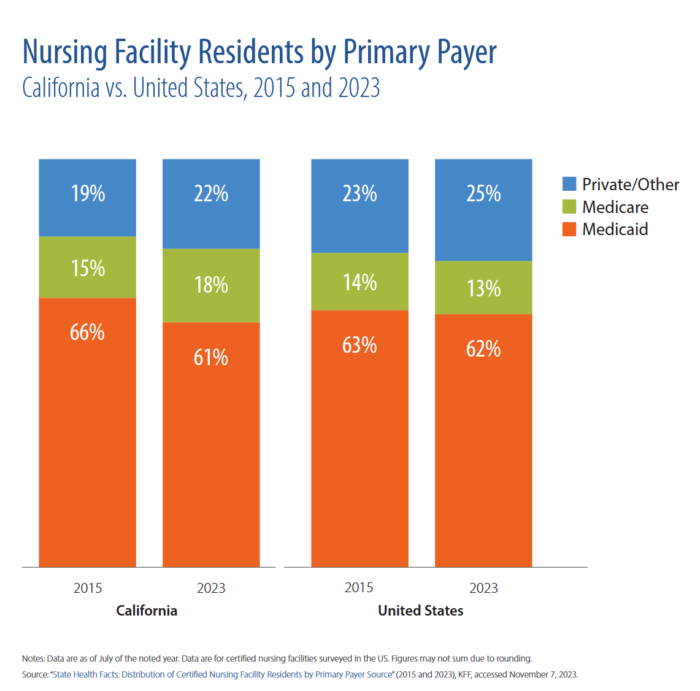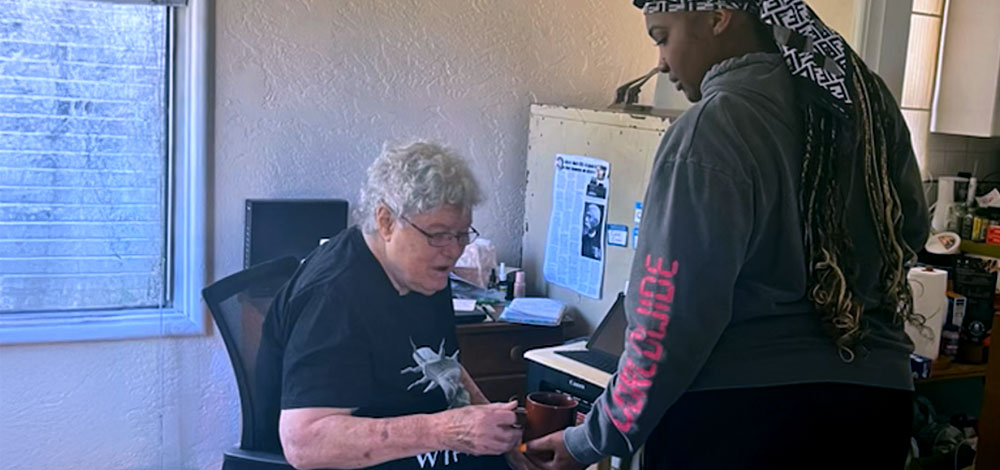Key Takeaways
- 1.7 million Californians are enrolled in both Medicare and Medi-Cal
- Medi-Cal is the primary payer for more than 6 in 10 Californians in nursing homes; Medicare covers only the first 100 days in nursing facilities
- For people enrolled in both Medi-Cal and Medicare, Medi-Cal covers the cost of Medicare premiums, which are often several hundred dollars each month
How does Medi-Cal support seniors?
Medi-Cal, California’s Medicaid program, provides health insurance to people with low incomes of all ages. More than 1.7 million Californians are enrolled in both Medicare and Medi-Cal, including adults age 65 and older and people with disabilities. For these groups, Medi-Cal covers essential services that are not covered by Medicare, such as nursing facility care; services that help people with cooking, bathing, and other daily tasks so they can live independently; and several other critical programs.
What are examples of programs Medi-Cal covers that Medicare does not?
Medi-Cal covers the costs of several programs known as “long-term services and supports,” which more than 1.1 million of California’s seniors and people with disabilities rely on every year. These programs include home and community-based services (HCBS) and long-term nursing home care that are not covered by Medicare. Medi-Cal makes it possible for seniors with low incomes to afford Medicare coverage by paying for monthly premiums and out-of-pocket costs. Medi-Cal also covers dental, vision, and hearing services for these seniors, while Medicare does not. More information on key Medi-Cal services on which seniors and people with disabilities depend can be found below.

Most seniors can’t pay for nursing homes without Medi-Cal.
Medi-Cal is the primary source of funding for more than 6 in 10 Californians in nursing facilities.
- Home and Community-Based Services: Medi-Cal pays for a wide range of essential services not covered by Medicare, such as the In-Home Supportive Services (IHSS) program, that help older adults live independently in their homes and avoid higher-cost nursing homes. In addition to covering the costs of personal care aides who help with day-to-day tasks like bathing, dressing, and housekeeping, HCBS programs include services that deliver nutritious food to seniors, home modifications that help prevent falls and injuries, transportation assistance getting to doctors’ appointments, and care management. Nearly one million Medi-Cal enrollees rely on these services every year. Without Medi-Cal, these services would be unattainable for seniors with low incomes, with private in-home care in California costing an average of $38 per hour.
- Long-Term Nursing Home Care: Medi-Cal is the primary payer of nursing home care for seniors. Over 100,000 California seniors receive short- or long-term care in nursing homes each year, and Medi-Cal is the primary payer for 61% of the state’s nursing facility residents (see chart). Medicare pays for up to just 100 days in a nursing facility and only after a qualifying hospitalization. For people without other insurance or the ability to pay out of pocket, Medi-Cal is the only option to pay for long-term stays, which cost an average of $137,000 per year.
- Medicare Cost Sharing: For people enrolled in both Medi-Cal and Medicare, Medi-Cal also covers the cost of Medicare premiums, which are often several hundred dollars every month, as well as out-of-pocket costs like copays and deductibles. Nationally, one in six Medicare enrollees (roughly 10 million people) rely on Medicaid to pay for the health care Medicare provides. In California, over 1.7 million seniors and people with disabilities have their Medicare premiums and out-of-pocket costs covered by Medi-Cal. Without coverage of these expenses, most seniors with low incomes would not be able to afford Medicare coverage. That’s why any cuts to Medi-Cal would reduce access to Medicare for California’s older adults with low incomes.
To learn more:
- Defending Medi-Cal in 2025
- CHCF Poll: Californians Across Party Lines Overwhelmingly Support the State’s Medicaid Program
- Medi-Cal and the Role of the Federal Government — Policy at a Glance
- Long-Term Care in California
- Medi-Cal Long-Term Services and Supports Dashboard (California Department of Health Care Services)
- A Cut to Medicaid is a Cut to Medicare (Justice in Aging)
- Federal Cuts to Medicaid Will Harm Older Californians on Medi-Cal (Justice in Aging)




